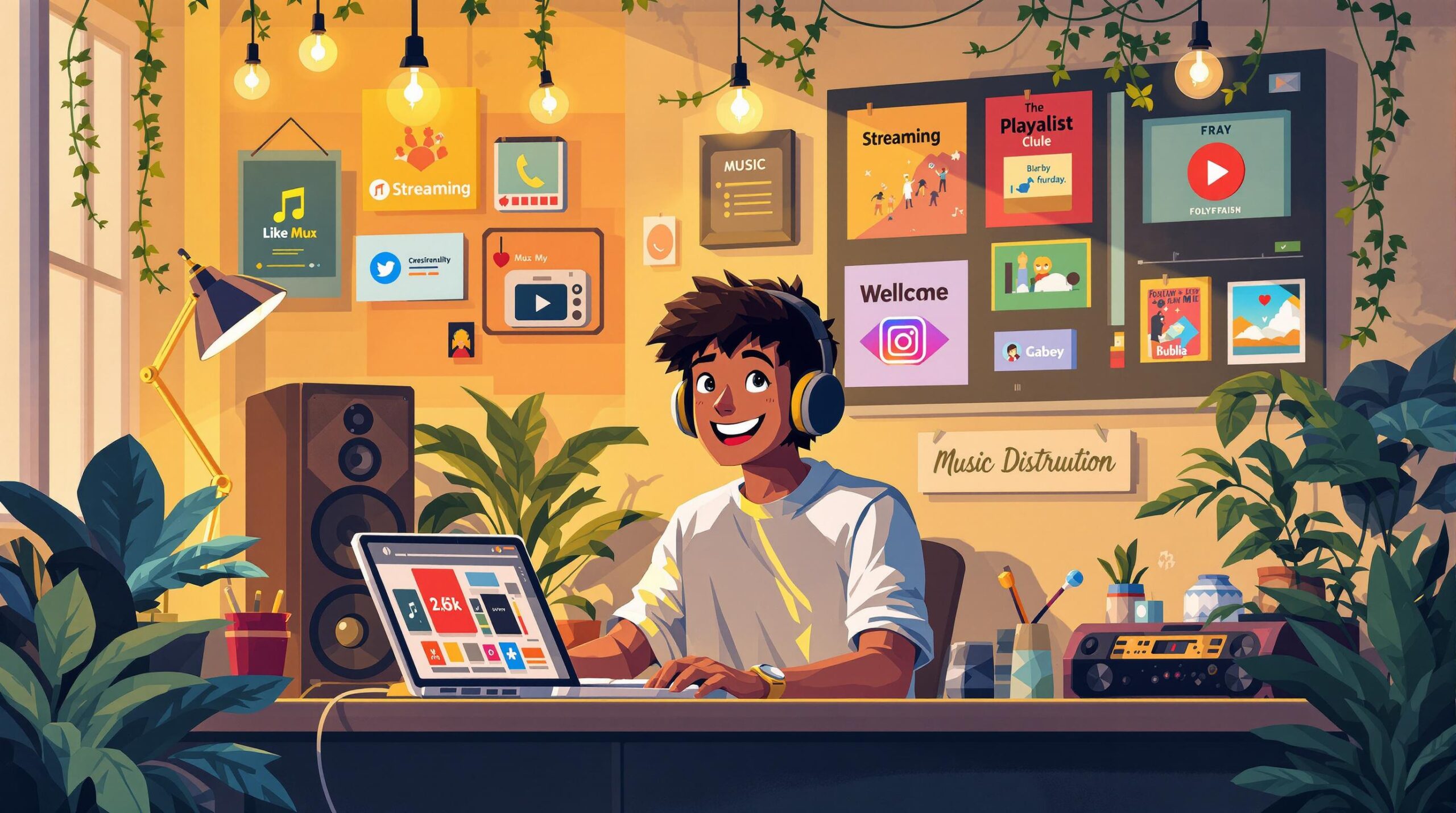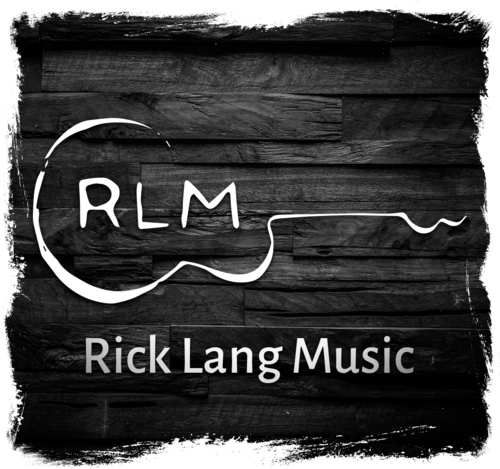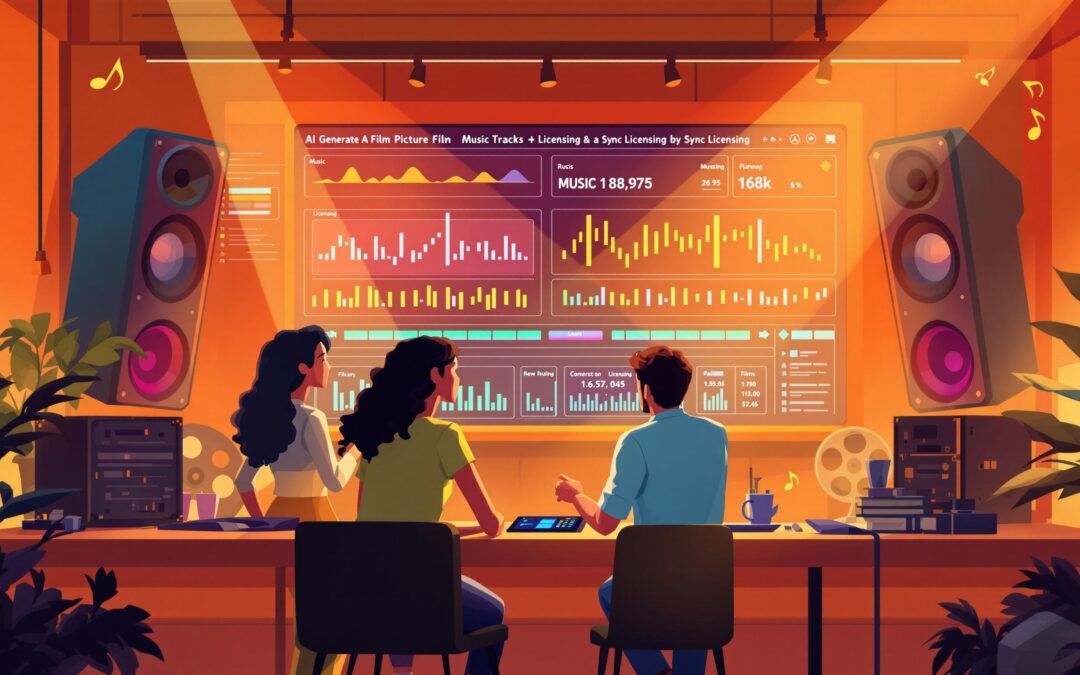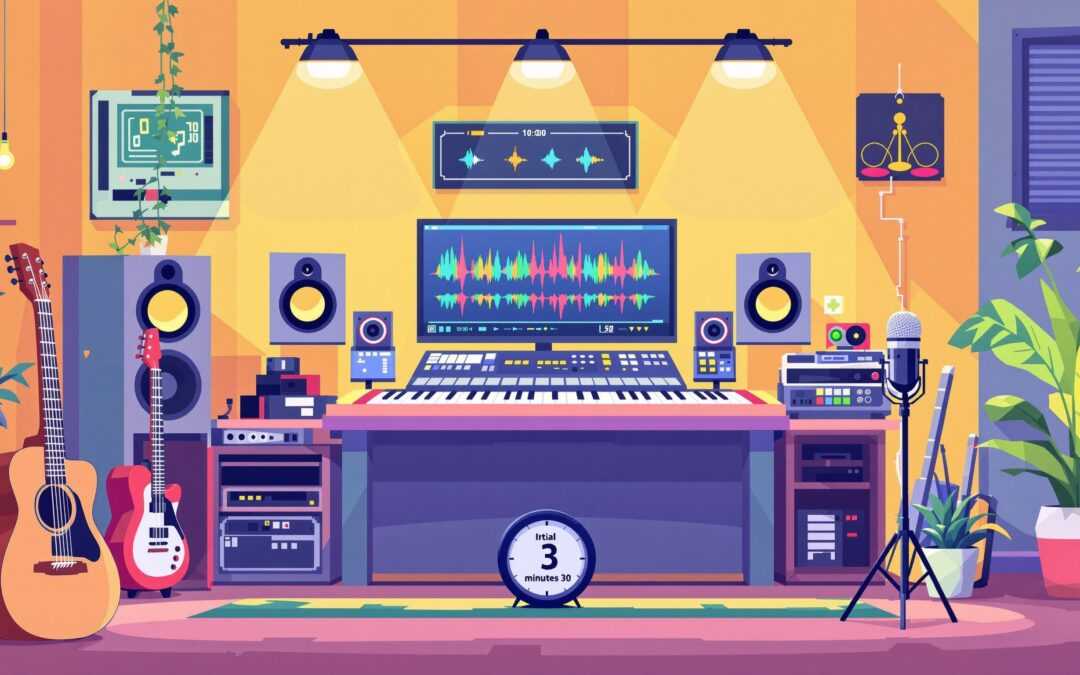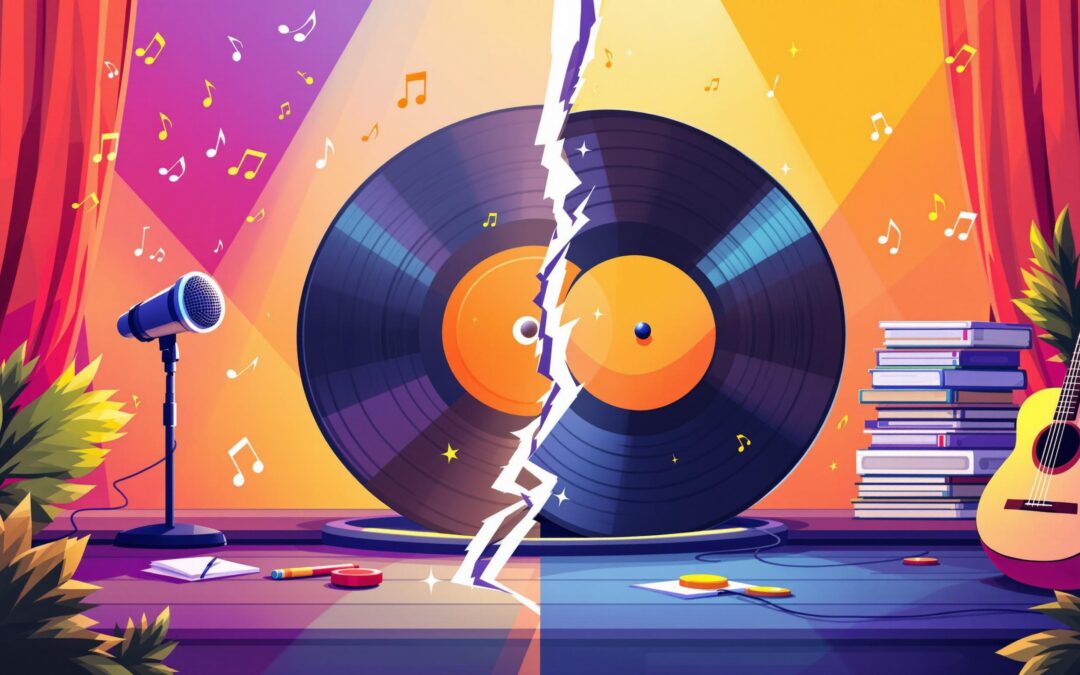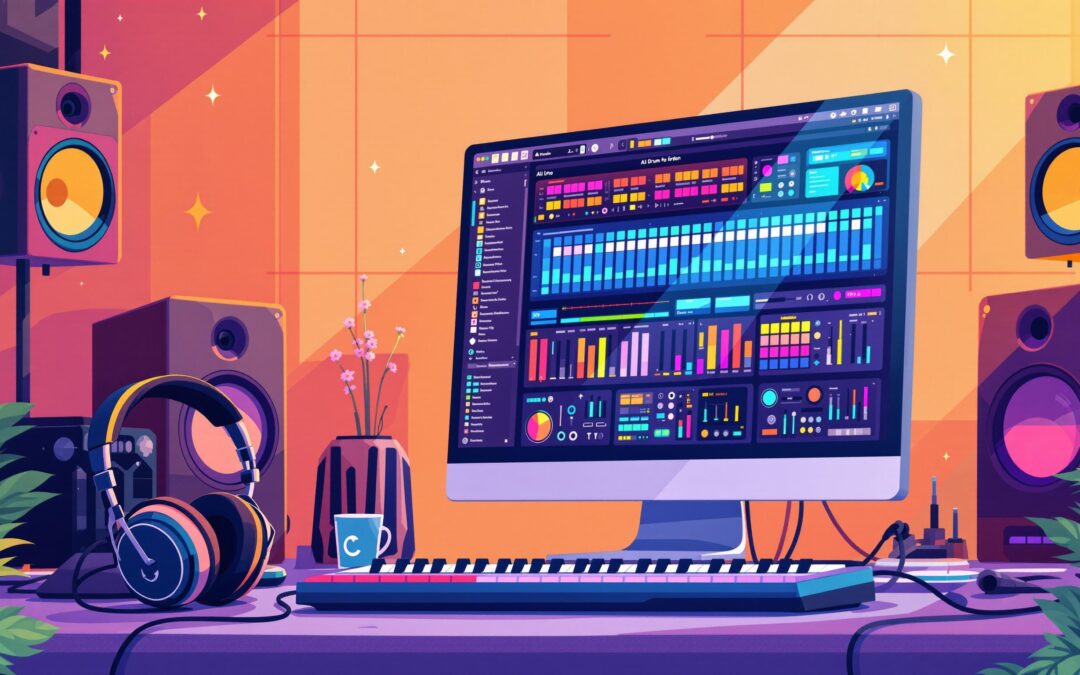In today’s crowded music scene, getting your music heard isn’t just about talent – it’s about smart distribution. With over 40,000 songs uploaded to Spotify daily, indie artists need effective strategies to stand out. Here’s a quick guide to mastering music distribution:
- Choose the Right Platform: Compare top distributors like DistroKid, TuneCore, and CD Baby based on cost, royalty splits, and features.
- Optimize Streaming Profiles: Claim and update your artist pages on Spotify and Apple Music. Use pre-save campaigns to boost visibility.
- Leverage Playlists: Pitch to editorial, algorithmic, and independent playlists to increase streams.
- Use Social Media: Share engaging content on platforms like TikTok, Instagram, and Facebook to connect with fans and promote your music.
- Explore Direct Sales & Licensing: Platforms like Bandcamp and Patreon let you sell directly to fans, while licensing opens income opportunities in media.
Quick Comparison of Top Distribution Platforms
| Feature | DistroKid | TuneCore | CD Baby |
|---|---|---|---|
| Annual Cost | $22.99 | $14.99 | $9.99/release |
| Release Limit | Unlimited | Unlimited | Pay per release |
| Royalty Split | 100% | 100% | 91% |
| Notable Features | Payment splitting | Revenue advances | Sync licensing |
Music Distribution is Changing (5 things to look for)
Pick Your Distribution Platform
Choosing the right platform for music distribution is a critical step in standing out. Your platform choice lays the groundwork for your success. Let’s break down how the top three services compare and what to consider when selecting one.
Top Distribution Services Compared
DistroKid, TuneCore, and CD Baby are the leading names in independent music distribution. Here’s a quick comparison of their key features:
| Feature | DistroKid | TuneCore | CD Baby |
|---|---|---|---|
| Annual Cost | $22.99 | $14.99 | $9.99 per release |
| Release Limit | Unlimited | Unlimited | Pay per release |
| Royalty Split | 100% to artist | 100% to artist | 91% to artist |
| Notable Features | Payment splitting | Revenue advances, store automator | Sync licensing, promotional tools |
DistroKid is currently responsible for distributing one-third of the world’s new music , making it a dominant player. However, each platform has its own focus and strengths, catering to different artist needs.
What to Look for in a Distributor
When evaluating music distribution services, consider the following factors:
- Platform Reach: Confirm that the distributor covers major streaming platforms like Spotify and Apple Music. Some even provide access to regional markets, such as China, which can be a game-changer for international reach.
- Payment Structure: The pricing models vary, as shown in the table above. Select one that matches your release frequency and budget .
"There is no ‘best music distribution company’ necessarily because each company has unique features that may be super important to some artists and not at all to others." – Ari Herstand, Founder and CEO of Ari’s Take
- Key Features: Look for tools like detailed analytics, Spotify pre-save campaigns, YouTube Content ID integration, payment splitting, and publishing administration. These features can simplify your workflow and help you grow.
Getting Your Music on Multiple Platforms
To ensure your music reaches as many listeners as possible, keep these tips in mind:
- Plan Ahead: Schedule your release 2–4 weeks in advance. This allows time for promotion, playlist pitching, and a synchronized launch across platforms .
- Prioritize Quality: Double-check that your tracks are professionally mastered, and make sure the artwork meets platform requirements. Poor quality submissions can lead to rejection or delays.
- Pick the Right Tier: For frequent releases, DistroKid’s unlimited plan offers great value. If you release music less often, CD Baby’s Pro Single might be a better fit, as it includes a range of additional services .
Set Up Your Streaming Profiles
Set Up Artist Profiles
Take control of your presence on platforms like Spotify for Artists and Apple Music for Artists. These tools help you manage your music, connect with fans, and analyze your audience.
For Apple Music, wait about five business days after your content goes live before claiming your artist page . Here’s what to focus on:
- Link your distributor accounts.
- Add your website and social media profiles.
- Upload professional photos.
- Write a short, engaging bio.
- Include your song lyrics .
"Spotify for Artists lets you manage your artist profile and get to know your fans." – Spotify for Artists
Run Pre-Save Campaigns
Pre-save campaigns are a great way to signal streaming platforms that your music is worth promoting. They can help you get featured in recommendation feeds and playlists .
Here’s how to create an effective campaign:
- Plan Ahead: Start 2–4 weeks before your release. Secure your song’s URI, create a landing page, and build excitement on social media.
- Set It Up: Use visuals that match your brand, include clear calls-to-action, and offer exclusive perks to fans. Don’t forget to collect email addresses .
- Promote It: Share your pre-save link everywhere, including:
- Your artist website
- Email newsletters
- Press releases
- Social media
- Fan groups and communities
Get on Playlists
Once your pre-save campaign gains traction, shift your focus to playlist placements. Playlists are a powerful way to boost streams. Since Spotify introduced its submission tool in 2018, about 20% of pitched tracks have made it onto playlists .
| Playlist Type | How to Get Featured | Best Practices |
|---|---|---|
| Editorial Playlists | Submit via Spotify for Artists | Pitch at least 7 days pre-release |
| Algorithmic Playlists | Build engagement (follows, saves) | Encourage fans to interact |
| Independent Playlists | Contact curators directly | Find playlists that match your genre |
"Give us the who, what, why, when, where, and how of your song… The music is key but context is also extremely helpful to us." – Spotify’s playlist editors
To improve your chances:
- Fully complete your Spotify artist profile.
- Share your profile on social media.
- Use Spotify’s Promo Cards to highlight your music.
- Build relationships with playlist curators.
- Target playlists that align with your genre .
Start small by pitching to independent, genre-specific playlists, then work your way up as your streams grow.
sbb-itb-1c6af30
Use Social Media for Distribution
Social media platforms play a crucial role for indie artists. With over 60,000 tracks uploaded to Spotify every day , it’s tough to stand out. A well-planned social media strategy can amplify your reach and strengthen your brand when integrated with your streaming profiles.
Create Your Artist Brand
Your social media presence should reflect a clear and consistent identity that fans can instantly recognize. Here’s how to get started:
Profile Optimization
- Add a link to your latest release in your bio.
- Use professional photos that align with your music style.
- Ensure your usernames are consistent across all platforms.
Visual Content Strategies on Social Platforms
| Platform | Best Content Types | Key Features |
|---|---|---|
| Visual storytelling, Stories | Behind-the-scenes, performance clips | |
| TikTok | Short-form videos | Trending challenges, song clips |
| Long-form content | Event promotion, fan community | |
| Real-time updates | Industry networking, fan engagement |
Make Content That Works
TikTok Strategy
- Share short, catchy clips from your songs.
- Join trending challenges to increase visibility.
- Post raw moments like practice sessions or studio recordings.
- Use bold, attention-grabbing visuals to stop the scroll.
Instagram Approach
- Use Stories to keep fans updated.
- Share snippets from your music videos.
- Post Reels featuring your tracks.
- Highlight your creative process through engaging posts.
"People like watching short videos, so with my music, I love creating small videos that I hope will trend… I use that to my advantage when promoting a song." – Tyla
These targeted strategies help boost engagement and direct listeners to your streaming platforms.
Build Your Music Network
Expanding your network can turn casual followers into active promoters, strengthening your distribution efforts.
Connect with Fans
- Reply to messages and comments within 24 hours.
- Share content created by fans to show appreciation.
- Host live Q&A sessions to engage directly.
- Use interactive features like polls and Stories.
Industry Connections
Collaborating with micro-influencers in your genre can be a game-changer. Their smaller, dedicated audiences often make these partnerships feel more personal and impactful .
1. Research First
Engage with potential collaborators’ content naturally before reaching out with a proposal.
2. Offer Value
Allow influencers to incorporate your music in ways that align with their content style.
3. Track Results
Keep an eye on metrics like streaming numbers and social media growth to evaluate the success of your collaborations.
Try Other Distribution Methods
Exploring different ways to distribute your music can help you reach more people and bring in extra income. These options work alongside your streaming and social media efforts to broaden your audience.
Sell Direct to Fans
Selling directly to your fans gives you more control over pricing and boosts your earnings. For instance, indie artists have earned a total of $1.46 billion through Bandcamp .
Why Bandcamp Stands Out
Bandcamp lets artists keep up to 82% of digital revenue. Their fees are straightforward: 15% for digital music and 10% for merchandise. Plus, they support multiple formats and encourage community engagement .
Make the Most of Your Bandcamp Profile
To stand out, focus on details like high-quality artwork, descriptive track listings, liner notes, and accurate tags. Hosting live-streamed album events can also help connect with fans .
Another option is Patreon, where you can offer exclusive content through different membership tiers .
License Your Music
Licensing your music is another way to earn while getting your work featured in media like TV shows, movies, commercials, or video games .
To succeed, ensure your music is "sync-ready." This means preparing high-resolution, clean, and instrumental versions of your tracks, along with formatted lyrics. Register with a Performance Rights Organization (PRO) like ASCAP or BMI, and secure your rights with proper documentation . You’ll also need professional assets, such as alternate mixes, stems, and metadata tags .
Work with Other Artists
Teaming up with other artists can open doors to new audiences by tapping into their fanbases. The rise in collaborations on Billboard Hot 100 tracks shows just how powerful these partnerships can be .
Tips for Collaborations
| Focus Area | Benefits | Action Steps |
|---|---|---|
| Genre Crossing | Attract new listener groups | Partner with artists in similar genres |
| Skill Exchange | Learn fresh techniques | Work with artists who have unique skills |
| Market Expansion | Reach fans in new regions | Collaborate with artists from other areas |
Choose collaborations that benefit both parties. For example, Ed Sheeran’s duet with Beyoncé on "Perfect" brought together fans from different backgrounds, creating a massive hit .
Check Your Results
Set Up Analytics Tools
Analytics are essential for shaping your music distribution strategy. Tools like Spotify for Artists and Bandcamp offer insights into listener activity and engagement.
Here’s a quick comparison of key platforms:
| Platform | Features | Key Metrics to Track |
|---|---|---|
| Spotify for Artists | Audience demographics, playlist data | Listener age, location, playlist adds |
| Bandcamp | Sales origins, community engagement | Purchase sources, follower interaction |
| Social Media | Engagement metrics, reach statistics | Shares, comments, click-through rates |
Start using these tools as soon as possible to collect valuable data. As TuneCore explains, “With detailed analytics, TuneCore helps track where your music is being listened to and how well it’s performing on each platform” .
Numbers That Matter
Once your analytics are set up, focus on the metrics that impact your growth. For example, consistent promotion can lead to a 15–20% increase in monthly streams per release .
Key metrics to track:
- Stream Growth: Keep an eye on monthly listeners and stream counts.
- Audience Engagement: Look at playlist adds and save rates.
- Geographic Reach: Understand where your audience is located.
- Platform Performance: Compare results across streaming services.
For instance, instrumental artist Arman Ayva built a regular following of 200–300 monthly Spotify listeners by maintaining a release schedule and promoting strategically .
Improve Based on Data
Use your analytics to fine-tune your strategy. Here are a few ways to optimize:
-
Visual Content Impact
High-quality visuals can increase streams by 15–20% after a release . Invest in artwork and videos that connect with your audience. -
Release Timing
Timing matters. Schedule releases when your listeners are most active. Bandcamp, for example, attributes 30% of its monthly sales to its community features . -
Platform Focus
Double down on platforms delivering the best results. Bandcamp has seen impressive growth in recent years:- Vinyl sales rose 438% over five years
- Cassette sales grew 232%
- T-shirt sales increased 250%
Keep reviewing your data and adjusting your strategy to stay ahead.
Conclusion: Next Steps for Distribution
Here’s how to expand your reach and make the most of your music distribution efforts.
Start with a solid plan:
| Platform | Key Features |
|---|---|
| DistroKid | Quick distribution, unlimited uploads, split earnings |
| TuneCore | In-depth analytics, publishing management, global reach |
| CD Baby | Physical and digital distribution, sync licensing, YouTube monetization |
Make sure you’re collecting performance royalties by registering with ASCAP or BMI. Also, consider protecting your brand by filing for a trademark with the USPTO.
Polish your online presence:
Spotify Marquee campaigns can help you reach over 10,000 listeners for around $140 . Boost your visibility by focusing on:
- High-resolution artwork (3000 x 3000 pixels or larger)
- Well-timed releases
- Reaching out to curated playlists
- Promoting across multiple platforms
Build direct relationships with your fans:
Use mailing list tools like MailChimp to stay connected with your audience. Keep your music and promo materials safe and accessible with cloud storage – this makes it easier to share with industry professionals. These personal connections are a key part of your distribution strategy.
For better results, submit your releases 4–6 weeks ahead of time to improve your chances of playlist placement . Track your performance using tools like Spotify for Artists, and adjust your approach based on the data. By following these steps, you’ll set yourself up for consistent growth with every release.
